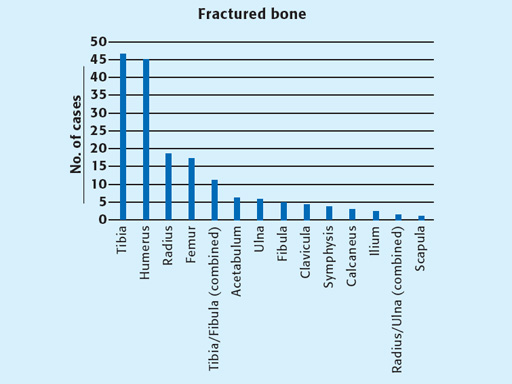
Early clinical experience with the LCP 3.5/4.5 systems
The aim of this prospective study was to systematically document the results of the first applications of the LCP system in routine clinical practice for a broad spectrum of indications. From March 2000 to February 2001 144 patients with 169 fractures were treated with the LCP system at six European trauma centers and at one American center. Patient recruitment was distributed across the individual centers as follows:
| Kantonsspital Chur | 39 patients |
| Kantonsspital Fribourg | 37 patients |
| Wilhelminenspital Wien | 24 patients |
| Hospital for Special Surgery New York | 20 patients |
| Kantonsspital Aarau | 9 patients |
| Spital Davos | 8 patients |
| Kantonsspital Luzern | 7 patients |
The patient sample was comprised of 67 women and 77 men aged between 11 and 93 years. The period from accident to operation was 62 days on average (minimum 0 and maximum 917 days).
For this study, a follow-up rate of 88.2% was achieved. Five patients died before fracture healing was concluded without there being any recognizable link between the cause of death and the implant. One year after the operation, 130 fractures had gone on to complete and uneventful healing. For 19 patients a total of 27 unexpected adverse events were documented.
| Adverse events | No. of cases |
| Delayed or nonunion | 5 |
| Loss of reduction | 1 |
| Loosening of implant | 1 |
| Loosening of implant & loss of reduction | 4 |
| Breakage of implant | 4 |
| Infection | 2 |
| Postoperative nerve palsy | 2 |
| Refracture (2nd fracture close to implant) | 4 |
| Implant-related pain | 2 |
| Osteonecrosis | 2 |
Table - Documented adverse events
The complications documented were of various degrees of severity and corresponded to a complication rate of 12.6%. None of these complications was determined to be purely implant-related. Instead, eight of the 18 revision operations were the consequence of technical inadequacies during the operation, or the stability of the osteosynthesis was overestimated
by the surgeon. The infection rate (2/151 of the fractures followed-up) is low (1.5%) for this heterogeneous patient sample that included numerous open fractures and many revision operations on patients who had already been operated on repeatedly (1.5%); this is especially true for the rate of secondary cancellous bone grafts (1.5%). The LCP system with its different types of screws and a very broad range of applications is of necessity associated with the hidden risks of error during operative planning and during operative intervention. The surgeons emphasized that, thanks to the possibility of fracture bridging fixation, the advantages of the LCP system lie especially in
- its good purchase in osteoporotic bone;
- the stable angle fixation of small, unstable fragments;
- the reduction of primary cancellous bone grafting.
Hazards and labeling
Due to varying countries’ legal and regulatory approval requirements, consult the appropriate local product labeling for approved intended use of the products described on this website. All devices on this website are approved by the AO Technical Commission. For logistical reasons, these devices may not be available in all countries worldwide at the date of publication.
Legal restrictions
This work was produced by AO Foundation, Switzerland. All rights reserved by AO Foundation. This publication, including all parts thereof, is legally protected by copyright.
Any use, exploitation or commercialization outside the narrow limits set forth by copyright legislation and the restrictions on use laid out below, without the publisher‘s consent, is illegal and liable to prosecution. This applies in particular to photostat reproduction, copying, scanning or duplication of any kind, translation, preparation of microfilms, electronic data processing, and storage such as making this publication available on Intranet or Internet.
Some of the products, names, instruments, treatments, logos, designs, etc referred to in this publication are also protected by patents, trademarks or by other intellectual property protection laws (eg, “AO” and the AO logo are subject to trademark applications/registrations) even though specific reference to this fact is not always made in the text. Therefore, the appearance of a name, instrument, etc without designation as proprietary is not to be construed as a representation by the publisher that it is in the public domain.
Restrictions on use: The rightful owner of an authorized copy of this work may use it for educational and research purposes only. Single images or illustrations may be copied for research or educational purposes only. The images or illustrations may not be altered in any way and need to carry the following statement of origin “Copyright by AO Foundation, Switzerland”.
Check www.aofoundation.org/disclaimer for more information.
If you have any comments or questions on the articles or the new devices, please do not hesitate to contact us.
“approved by AO Technical Commission” and “approved by AO”
The brands and labels “approved by AO Technical Commission” and “approved by AO”, particularly "AO" and the AO logo, are AO Foundation's intellectual property and subject to trademark applications and registrations, respectively. The use of these brands and labels is regulated by licensing agreements between AO Foundation and the producers of innovation products obliged to use such labels to declare the products as AO Technical Commission or AO Foundation approved solutions. Any unauthorized or inadequate use of these trademarks may be subject to legal action.
AO ITC Innovations Magazine
Find all issues of the AO ITC Innovations Magazine for download here.
Innovation Awards
Recognizing outstanding achievements in development and fostering excellence in surgical innovation.





